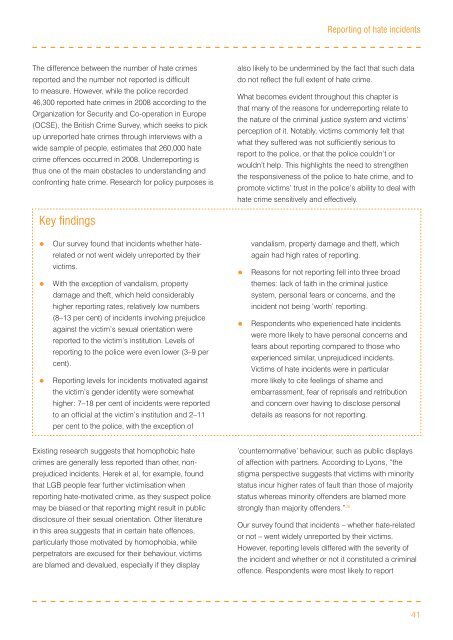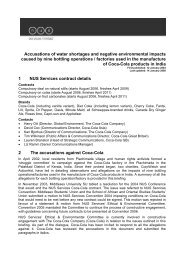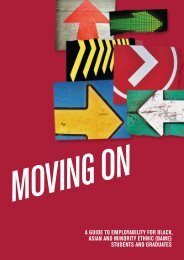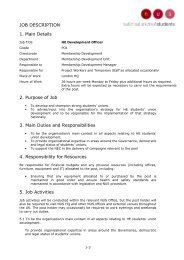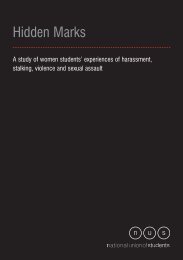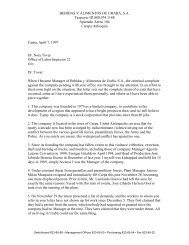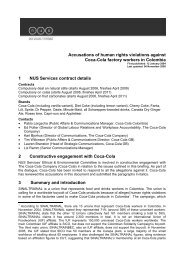No Place for Hate Crime - National Union of Students
No Place for Hate Crime - National Union of Students
No Place for Hate Crime - National Union of Students
You also want an ePaper? Increase the reach of your titles
YUMPU automatically turns print PDFs into web optimized ePapers that Google loves.
Reporting <strong>of</strong> hate incidents<br />
The difference between the number <strong>of</strong> hate crimes<br />
reported and the number not reported is difficult<br />
to measure. However, while the police recorded<br />
46,300 reported hate crimes in 2008 according to the<br />
Organization <strong>for</strong> Security and Co-operation in Europe<br />
(OCSE), the British <strong>Crime</strong> Survey, which seeks to pick<br />
up unreported hate crimes through interviews with a<br />
wide sample <strong>of</strong> people, estimates that 260,000 hate<br />
crime <strong>of</strong>fences occurred in 2008. Underreporting is<br />
thus one <strong>of</strong> the main obstacles to understanding and<br />
confronting hate crime. Research <strong>for</strong> policy purposes is<br />
also likely to be undermined by the fact that such data<br />
do not reflect the full extent <strong>of</strong> hate crime.<br />
What becomes evident throughout this chapter is<br />
that many <strong>of</strong> the reasons <strong>for</strong> underreporting relate to<br />
the nature <strong>of</strong> the criminal justice system and victims’<br />
perception <strong>of</strong> it. <strong>No</strong>tably, victims commonly felt that<br />
what they suffered was not sufficiently serious to<br />
report to the police, or that the police couldn’t or<br />
wouldn’t help. This highlights the need to strengthen<br />
the responsiveness <strong>of</strong> the police to hate crime, and to<br />
promote victims’ trust in the police’s ability to deal with<br />
hate crime sensitively and effectively.<br />
Key findings<br />
• Our survey found that incidents whether hate-<br />
related or not went widely unreported by their<br />
victims.<br />
• With the exception <strong>of</strong> vandalism, property<br />
damage and theft, which held considerably<br />
higher reporting rates, relatively low numbers<br />
(8–13 per cent) <strong>of</strong> incidents involving prejudice<br />
against the victim’s sexual orientation were<br />
reported to the victim’s institution. Levels <strong>of</strong><br />
reporting to the police were even lower (3–9 per<br />
cent).<br />
• Reporting levels <strong>for</strong> incidents motivated against<br />
the victim’s gender identity were somewhat<br />
higher: 7–18 per cent <strong>of</strong> incidents were reported<br />
to an <strong>of</strong>ficial at the victim’s institution and 2–11<br />
per cent to the police, with the exception <strong>of</strong><br />
vandalism, property damage and theft, which<br />
again had high rates <strong>of</strong> reporting.<br />
• Reasons <strong>for</strong> not reporting fell into three broad<br />
themes: lack <strong>of</strong> faith in the criminal justice<br />
system, personal fears or concerns, and the<br />
incident not being ‘worth’ reporting.<br />
• Respondents who experienced hate incidents<br />
were more likely to have personal concerns and<br />
fears about reporting compared to those who<br />
experienced similar, unprejudiced incidents.<br />
Victims <strong>of</strong> hate incidents were in particular<br />
more likely to cite feelings <strong>of</strong> shame and<br />
embarrassment, fear <strong>of</strong> reprisals and retribution<br />
and concern over having to disclose personal<br />
details as reasons <strong>for</strong> not reporting.<br />
Existing research suggests that homophobic hate<br />
crimes are generally less reported than other, nonprejudiced<br />
incidents. Herek et al, <strong>for</strong> example, found<br />
that LGB people fear further victimisation when<br />
reporting hate-motivated crime, as they suspect police<br />
may be biased or that reporting might result in public<br />
disclosure <strong>of</strong> their sexual orientation. Other literature<br />
in this area suggests that in certain hate <strong>of</strong>fences,<br />
particularly those motivated by homophobia, while<br />
perpetrators are excused <strong>for</strong> their behaviour, victims<br />
are blamed and devalued, especially if they display<br />
‘counternormative’ behaviour, such as public displays<br />
<strong>of</strong> affection with partners. According to Lyons, “the<br />
stigma perspective suggests that victims with minority<br />
status incur higher rates <strong>of</strong> fault than those <strong>of</strong> majority<br />
status whereas minority <strong>of</strong>fenders are blamed more<br />
strongly than majority <strong>of</strong>fenders.” 26<br />
Our survey found that incidents – whether hate-related<br />
or not – went widely unreported by their victims.<br />
However, reporting levels differed with the severity <strong>of</strong><br />
the incident and whether or not it constituted a criminal<br />
<strong>of</strong>fence. Respondents were most likely to report<br />
41


